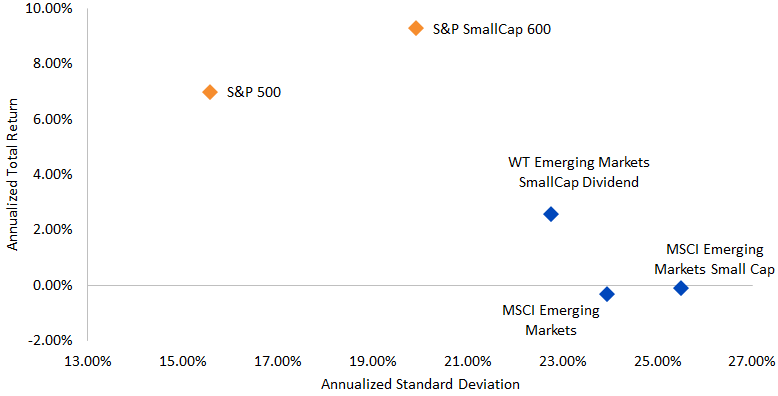Is It Possible for Small Caps to Outperform Large Caps with Less Risk?


Most investors have heard of the “size premium,” the well-documented and academically studied tendency for small-cap companies to outperform large-cap companies over time, but with additional risk. For example, we can see this phenomenon in the table below. The S&P SmallCap 600 Index outperformed the S&P 500 Index by 229 basis points (bps) annualized over 9.5 years,1 but did so while increasing standard deviation by over 4 percentage points relative to the S&P 500.2
But what if it were possible to capture the size premium with volatility similar to large caps while also helping to complete balanced, globally diversified exposure? Well, in the emerging market (EM) space, it has been possible. Though the relative outperformance is less pronounced than in the U.S., over the last 9.5 years, the MSCI Emerging Markets Small Cap Index was able to outperform the MSCI Emerging Markets Index while increasing annualized volatility by just 1.6 percentage points.3 This was a much narrower spread in volatility than was seen when moving down the size spectrum in the U.S., but it did maintain the relationship between large- and small-cap risk, nonetheless.
Index Risk and Return, 8/1/07–12/31/16


For definitions of indexes in the chart, visit our glossary.
Less Volatility While Maintaining Excess Returns
The question then becomes, what if one differentiated EM small-cap exposure, aiming to gain superior risk-adjusted returns relative to cap-weighting? Could it then be possible for EM small caps to have even less volatility than cap-weighted large caps while maintaining excess returns?
WisdomTree achieved this counterintuitive conclusion over the same 9.5 years previously observed, beginning when it launched the WisdomTree Emerging Markets SmallCap Dividend Index. This small-cap Index has managed to outperform both cap-weighted large- and small-cap indexes by an average of over 250 bps per year while actually reducing annualized volatility relative to cap-weighted EM large caps by more than a percentage point.4 A small-cap index outperforming a large-cap index with less risk may be hard to believe, but we think it all starts with intuitive, intelligent and simple design.
WisdomTree’s Approach
WisdomTree created the parent Index—the WisdomTree Emerging Markets Dividend Index—which seeks to capture virtually all investable EM stocks that pay dividends, in 17 countries. We then cut that Index by excluding the top 90% by market cap and weighting the remaining 10% small-cap companies by their share of the aggregate dividends paid over the last year, rather than market value. This creates differentiated sector exposures and access to value and quality characteristics, and it typically raises the dividend yield relative to cap weighting. In fact, as of 12/31/16, the WisdomTree Emerging Markets SmallCap Dividend Index exhibited a dividend yield of 4.5%, compared to the 2.5% of the MSCI Emerging Markets index and the 2.2% of the MSCI Emerging Markets Small Cap index.5
Conclusion
With almost a decade of history, the WisdomTree Emerging Markets SmallCap Dividend Index has proven its ability to be a “better beta” for the emerging markets small-cap asset class. It seeks to provide broad, diversified and differentiated EM exposure, and has managed to do it with lower volatility than even the comparable large-cap, cap-weighted index. On October 30, 2007, WisdomTree launched an exchange-traded fund (ETF) that seeks to track this Index, the WisdomTree Emerging Markets SmallCap Dividend Fund (DGS). WisdomTree believes DGS can play an important role in the completion of a globally diversified portfolio.
1Here and throughout the post, 9.5 years was selected to reflect a common time period with the WisdomTree Emerging Markets SmallCap Dividend Index.
2The S&P 500 Index had 96% weight in large caps and the S&P SmallCap 600 Index had 63% weight in small caps as of 12/31/16. Source: WisdomTree, FactSet.
3The MSCI Emerging Markets Index had 63% weight in large caps and the MSCI Emerging Markets Small Cap Index had 91% weight in small caps as of 12/31/16. Source: WisdomTree, FactSet.
5WisdomTree, FactSet as of 12/31/16
Important Risks Related to this Article
Diversification does not eliminate the risk of experiencing investment losses.There are risks associated with investing, including possible loss of principal. Foreign investing involves special risks, such as risk of loss from currency fluctuation or political or economic uncertainty. Funds focusing on a single sector and/or smaller companies generally experience greater price volatility. Investments in emerging, offshore or frontier markets are generally less liquid and less efficient than investments in developed markets and are subject to additional risks, such as risks of adverse governmental regulation, intervention and political developments. Due to the investment strategy of this Fund, it may make higher capital gain distributions than other ETFs. Please read the Fund’s prospectus for specific details regarding the Fund’s risk profile.

